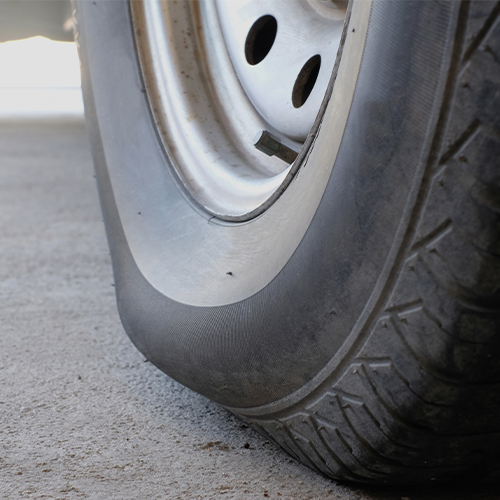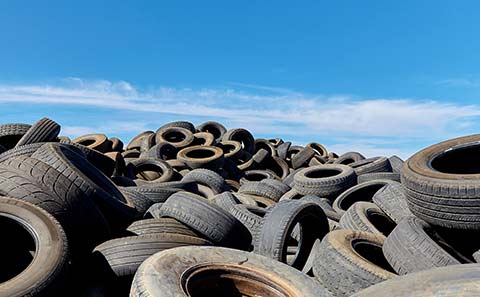Proper tire care significantly improves the average tire life. It ensures slow and even tread wear along the footprint. Tire wear patterns will easily identify what the problem is. However, vehicle owners need to know what to look out for. Tire and car maintenance are key factors!
How long do new tires last with regular tire maintenance?
The answer is longer than usual. Here’s how you can achieve this!
Why is Tire Maintenance so Important?
Proper tire care is crucial to ensure your driving safety. Experiencing tire problems can result in versatile issues related to your vehicle. But, why is this?
Tires are literally the only part of the vehicle that is in contact with the road. Therefore, experiencing a bad tire can easily lead to other complications.
Vehicle maintenance should be a habit, but sadly tires are often neglected.
How Long do Tires Last on Average?
The answer to the “how long can a tire last?” question is about 50,000 miles. However, some factors, like driving habits, frequency of use, and weather and road conditions, can easily shorten this number. Yet, modern tire technology has allowed tire manufacturers to design and produce more durable models. These tires can last anywhere up to 100,000 miles.
This is How You Identify Tire Wear Problems in Time
Tire and vehicle maintenance are important to ensure a safer performance – we have mentioned this before. So, what happens when you do not keep up with them?
Improper tire care will result in uneven and accelerated tire wear patterns, a flat tire, or even a blown-out tire. Therefore, in order to prevent being stranded on the side of the road, these are the signs a tire exchange is in order.
Signs to Look For During Visual Tire Inspection
Visual inspection is one of the easiest ways to go about tire inspection. Problems with tires can be easily identified simply just be looking at them.
To inspect tires, look for the following issues:
- Inflation problems: A tire’s over- or underinflation will result in uneven tire wear, as they place pressure only on certain tread areas.
- Irregular tread wear: Incorrect wheel alignment can cause uneven wear across the tread area by running the tires on their shoulder area.
- Accelerated tread wear: Out-of-balance tires or worn shock absorbers are often the root problem of tire cupping and premature tire wear patterns.
- Sidewall bulges: When the belts separate from the tire casing, they create a bulge or bubble on the tire’s sidewall, which is dangerous.

Identify Tire Problems while Driving
Tire inspection does not end with visually checking them. Keep your senses sharp when driving to notice anything out of the ordinary.
If you have bad tires, you will notice the following:
- Increased vibrations and noise: If you notice an increase in vibrations and road noise the culprit might be improperly balanced tires, tire feathering, flat sports, or a separated belt.
- Steering problems: When the vehicle pulls to one side, either the tires or the vehicle might be the problem – underinflation, feathering tire wear, brake issues, and poor wheel alignment among others.
If you notice any of the above-mentioned, be sure to contact your mechanic. The issues can lay with the tires or the vehicle, but it is better to have everything inspected.
Learn what causes irregular and uneven tread wear with this neat tire wear chart:

Keep Your Tire Tread Depth in Check
There are versatile methods vehicle owners can use to check the tread depth of their tires. While some are not as accurate as others, they will still provide a good insight into the tire wear and its conditions.
The most precise results are offered by a tire gauge. This clever little tool is used to measure the tread life of tires by placing it into the grooves and, usually, pushing it down. As a result, you bring the measuring part down to the tread, showing how much tread life in 32nds of an inch is left on the footprint.
The penny test is the other popular tool, and all you need is just a penny. This works by placing the penny upside-down into the tire’s grooves. If you can see the top of Lincoln’s head, the tread is lower than the legal limit (2/32″). In such cases, the tires need to be switched immediately, as they do not provide safe traction anymore.
Use a Quarter Instead of a Penny
A better option would be to measure the tread with a quarter if you do not have a tire gauge.
It is basically the same method as the penny test, but it uses a quarter. Place the quarter into the groove, upside-down. If you cannot see the top of Washington’s head, the tires have at least 4/32″.
A standard passenger vehicle tires are required to have a minimum tread depth of 2/32″. This gives you a bit more time to shop for tires. If a tire fails the quarter test, it is still usable for some time. However, failures with the penny test should not be driven on.
Keep Your Tires Properly Inflated
Tires should be kept within the recommended air pressure levels provided by vehicle manufacturers. It is important that the tires you purchase for your car match the recommended pressure in the vehicle’s owner’s manual or its driver’s door jamb.
Tire wear and performance are greatly affected by psi (pounds per square inch) levels. This is the measurement used to determine if tires are running at the recommended pressure levels or not. The psi range for tires depends on the type of vehicle they are for. However, generally speaking, passenger car tires will run at 35-41 psi.

Checking your tires at least once a month is a good practice. Inspecting tires after running over a pothole or sudden temperature changes is also favored. However, one rule you need to keep in mind is to do this when the tires are cold.
Tire pressure increases with temperature, which includes driving heat as well. Therefore, to get the best, most accurate results, do this before using the car.
Here’s How You Check Your Tire Pressure
- Be sure the tires are cold before you remove the valve stem’s cap
- Put the air pressure gauge over the tire’s valve stem and press down – this way the tire gauge will show psi levels
- If the tire is overinflated or underinflated, adjust the pressure levels
- Once everything it good, check the pressure once more and replace the valve cap
- Repeat on all four tires (five if you have a spare)
The Three Most Important Elements of Tire Maintenance
Apart from air pressure levels, other factors can also greatly shorten tire life. For this reason, practicing proper tire maintenance is vital.
“How long are tires good for?” has a drastically different answer if proper tire care is neglected.

Tire Rotation
Tire rotation is the practice of switching up the position of individual tires on a car. This allows all four (or five) tires to wear in the same manner, at the same speed by optimizing the uneven tire pressure affecting them.
In other words, tires in the wheel-drive position are given a break for a while. Specific tire rotation patterns need to be followed depending on the wheel-drive of the vehicle. It is important that the proper tire rotation patterns are used, as it will ensure the length of the tire life.
If tires are not rotated, two tires are more likely to wear out sooner than the others.
Tire Balancing
Tire balancing makes sure the tires are not vibrations during the drive. Improperly balanced tires not only cause a bumpy ride, but also develop spotty tire wear, also known as cupping.
Tread cupping, or flat spots along the footprint, are tire wear signs that the tires are not correctly balanced. Neglecting to fix this issue will result in the tire’s increased tread wear. Furthermore, it can easily lead to loss of control over the vehicle.
Sometimes a bad tire cannot be balanced. This is result in it not keeping constant contact with the road. Unfortunately, vehicle owners need to replace such tires, as they can cause other problems down the line.
Wheel Alignment
Wheel alignment is a vehicle maintenance issue that can affect the tires and cause uneven tire wear. When you see shoulder wear on tires, the vehicle’s improper alignment is usually to blame.
A properly aligned vehicle’s tires will maintain surface contact with its entire footprint. This allows driving pressure to equally affect all tread areas. However, when the alignment is poor, the tires are only running on one side, either the inner or outer shoulder area.
Since driving pressure accumulates in those areas, the tread wears away faster. This is what causes tires to wear on the outside or inside shoulders. Additionally, it also significantly shortens the average tire mileage.
Make Your Tires Last Longer by Avoiding Bad Driving Habits
Apart from proper tire care and vehicle maintenance, driving habits can also result in premature and uneven tire wear. The answer to how to make tires last longer might just be in the way you drive.
So, what should you look out for?
Tire lifespan depends on your driving habits. Consider changing these to minimize tire wear:
- High Speed Driving – Keep the tires’ speed limit, as pushing them past their limit will cause premature wear. Furthermore, it can cause a tire sidewall blowout, as well as damage vehicle parts.
- Rough Maneuvering – Shoulder wear on tires and tire feathering can also be from spirited cornering and braking, as it places extra pressure on these tread areas. Slower maneuvering will increase tread life.
- Bad Road Conditions – Off-road or unpaved surfaces can damage tires. Therefore, slower driving is recommended when you take your vehicle off paved roads. Driving at full speed not only shortens tire life, but can also result in tire failures.
- Dry Steering – Don’t turn the steering wheel when the vehicle is not moving. It placed pressure on the tread area in contact with the road. This results in tire feathering and cupping. Only use the steering wheel when the car is in motion.
We are not saying that someone is a bad driver if they do these things. However, it most certainly placed additional strain on the tires, which should be kept in mind.
Frequently Asked Questions
How Many Years do Tires Last?
Tire manufacturers recommend changing tires on your vehicle every 3 to 5 years. When tires are used frequently, their tread wears away within this timeframe. However, if the tires are not in use and are stored correctly, their lifespan can be anywhere from 6 to 10 years.
What Would Cause a Tire to Wear on the Outside?
Usually, excessive tire wear on the outside shoulder is caused by poor vehicle alignment. Bad toe and camber angles cause the tires to be on one shoulder. As pressure is only applied to that tread area, the tread wears away more quickly. In other words, wheel alignment causes uneven wear on one side.
What Causes Tires to Blow Out?
A blown-out tire can be the result of multiple factors. The causes of tire blowout can be low air pressure levels, road hazard damage, uneven tread depth, punctures, or running the tires with too much weight. These create pressure build-up that weakens the structure and ends in a blown-out tire.


